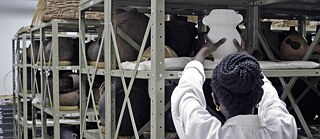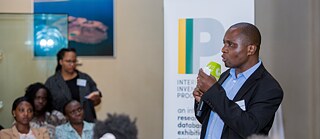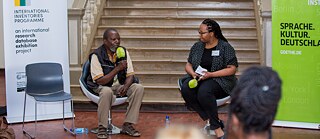"Invisible Inventories"
The Return to Wakanda

At the end of November 2019, the launch of the exhibition project "Invisible Inventories", which is supported by the Goethe-Institut, took place in Kenya. At the "Object Movement Dialogue #4" in the Nairobi National Museum, the role of local communities within the restitution debate was discussed. The Kenyan journalist Abigail Arunga was on site for "Goethe aktuell".
By Abigail Arunga
In the well-known Marvel-movie “Black Panther”, Michael B Jordan’s character gives a schooling to a museum official, explaining that the artefact on display is not really, originally, where that artefact is from. As in the fictitious world of Wakanda, it looks today in many museums worldwide. According to Juma Ondeng’ of the National Museums of Kenya (NMK), who spoke before the panel begun, a high number of objects on display all over the world do not belong to the countries of the museums they are housed in. Most of these objects are in collection with very few displayed in exhibitions. Kenya, through the International Inventories Programme (IIP), has a written, verifiable record of slightly over 18,000 objects in 22 institutions in 4 countries in the global North. The trend of being a display showcase for “exotic” objects is echoed all over the global North, with some museum collections being almost 90 percent foreign. And this ranges from Kenya and Greece to Ethiopia and Australia. After a significant silence, months of waiting, the British Museum only recently responded to communication from IIP and agreed to list the artifacts from Kenya in its museum, regardless of or perhaps because of our blood-splattered history.

Who is allowed to speak on behalf of a nation?
It is this history that brings us here; most historical objects of significant value that Kenya does not possess are in the possession of our colonizers. These include but are not limited to the head of resistance fighter Koitalel Arap Samoei, and the man-eating lions of Tsavo, which Juma Ondeng’ laughingly described as ‘the first frontier of resistance against colonial rule.’ He mentioned that the role of forums like these should be garnering public opinion, as the NMK cannot speak on behalf of Kenya as a nation.
The undertaking of establishing a database that details all the locations and objects in foreign museums is under the wing of the “Invisible Inventories Programme”, whose launch took place at the Nairobi National Museum in Kenya on the evening of the 28th of November, 2019. A crowd of approximately 70 people attended “Object Movement Dialogue #4“ that heralded the exhibition which will be on display at the Nairobi National Museum next year, as well as two German museums in 2021. This discussion was facilitated by Dr Njoki Ngumi of The Nest Collective, who are part of the three groups that form the foundation of IIP. The guest speaker of the evening was Mr. Jimbi Katana, who is a renowned archaeologist and has previously worked for the National Museums of Kenya.

Museums are custodians of tangible and intangible national heritage
Mr. Katana focuses on the research and preservation of heritage, particularly around the objects known in the Coast as ‘vigango’ – objects that the communities revered as embodiments of spirits. “If you die, you must be brought back home,” he said. Most forms of African traditional religion or mythology expressly emphasize the thoughts of the afterlife and the living world’s relationship with it; therefore the thought of vigango is natural to a typical African. For once you uproot something, whether a life, or a tree, or a sacred object, what happens to the vacuum left behind? It must be filled. The object must be returned.
Restitution and the dynamics of power
An audience member questioned why we were insisting on not calling the act of taking these objects as stealing, and out and out stating that this was a crime, instead of pussyfooting around the idea that we are asking to record databases and not claim our property back. However, as was explained, there are phases involved in the reacquisition and reclamation, simply because the dynamics of power in the global north with the global south are a different ball game all together.
Public participation is a pillar of the Kenyan constitution, and the only way the necessary work will be done to push the global north into returning these artefacts will be through the education that forums like these provide that will in turn push Kenyans to urge their parliamentarians and government bodies to get back what is already rightfully ours – no matter how uncomfortable these open and public conversations are.